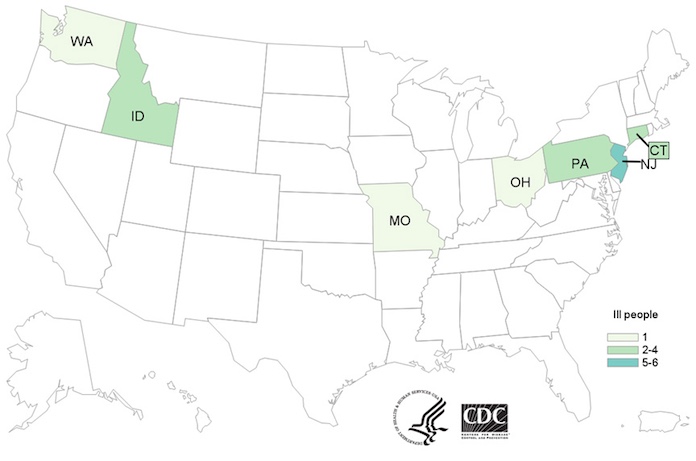A multistate outbreak of E. coli O157:H7 infections is being investigated by the CDC, several states, the FDA, and the USDA. This is a continuation of the outbreak that started in New Jersey and was reported on by the New Jersey Department of Health.

Earlier this week, the NJDOH reported that seven people were sick with E. coli infections in an outbreak that may be associated with a restaurant chain. Now, at least 17 people in 7 states are sick. Six people have been hospitalized. No deaths have been reported.
Investigators are using the PulseNet system to find people who may be part of this particular outbreak. DNA fingerprinting has been performed on isolates taken from ill persons using pulsed-field gel electrophoresis (PFGE) and whole genome sequencing (WGS).
Lab testing is ongoing to link the original outbreak in New Jersey to this larger outbreak. Some people may not be included in the CDC’s case count because no isolates were available for testing.
As of April 9, 2018, 17 people are sick. The case count by state is: Connecticut (2), Idaho (4), Missouri (1), New Jersey (6), Ohio (1), Pennsylvania (2), and Washington (1). Illnesses started on dates ranging from March 22, 2018 to March 31, 2018. The patient age range is from 12 to 84 years. Six people have been hospitalized, including one person who developed hemolytic uremic syndrome (HUS), which is a type of kidney failure.
A specific food item, grocery store, or restaurant chain has not been identified as the source. The government is asking anyone who is experiencing the symptoms of an E. coli O157:H7 infection or HUS to see their doctor. Then write down what you ate the week before you got sick. Report your illness to the death department, and be available for interviews, if possible.
The symptoms of a Shiga toxin-producing E. coli O157:H7 infection include diarrhea that is bloody, severe stomach cramps, and vomiting. These symptoms usually appear 2 to 8 days after exposure to the bacteria. The symptoms of HUS include little or no urine output, abdominal pain, pale skin, fatigue and irritability, smell bruises, and bleeding from the nose or mouth. This infection and HUS can both be deadly, so anyone who is ill with these symptoms should seek emergency medical care.
Because a specific source has not been identified, the CDC is not recommending that consumers avoid any particular food at this time. Meanwhile, follow the basic rules of food preparation safety.
Experienced attorneys at the noted law firm Pritzker Hageman help people who have been sickened by contaminated food protect their legal rights and get answers and compensation. Our lawyers help patients and families of children in personal injury and wrongful death lawsuits against restaurants, grocery stores, schools, retailers, food processors, and others. Attorney Fred Pritzker recently won $7.5 million for a young client whose kidneys failed after he developed hemolytic uremic syndrome after he contracted an E. coli infection. You should know that class action lawsuits may not be appropriate for outbreak victims because each individual case is so very different.




